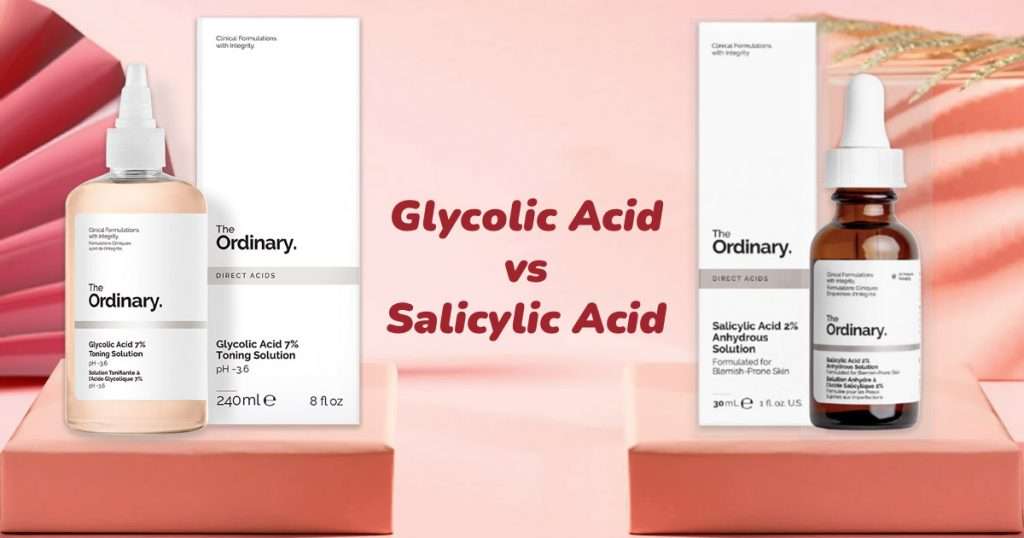Are you looking to up your skincare game and achieve smoother, clearer skin? Look no further than glycolic and salicylic acids! These two powerful substances are popular choices in the skincare world, each providing specific advantages to your skin. Whether you’re dealing with acne, dullness, or uneven skin texture, glycolic and salicylic acids are here to help you put your best face forward.
Glycolic Acid vs. Salicylic Acid: Getting To Know Each Exfoliant
Salicylic acid and glycolic acid are two types of acids commonly used in skincare products.
Glycolic Acid: The Exfoliating AHA
Glycolic acid acts as a helpful helper for your skin. It’s an acid known as alpha hydroxy acid or simply AHA. Picture it as a gentle exfoliator made from sugarcane. Gently, it gets rid of dead skin cells that can make your face look dull and rough.
So, using glycolic acid-containing skincare products is similar to giving your skin a refreshing boost. Your skin will feel smoother and brighter as if it had a good night’s sleep!
Salicylic Acid: The Deep-Penetrating BHA
Imagine salicylic acid as a superhero for your skin, fighting acne and blackheads! It’s a type of acid called beta hydroxy acid, or BHA for short, and it comes from willow bark. What makes it so special is that it’s like a ninja that can sneak into your pores because it dissolves in oil.
Once it’s inside, it works to unclog your pores, which is great for treating acne and getting rid of those pesky blackheads. So, when you use skincare products with salicylic acid, you’re giving your skin a powerful ally in the fight against breakouts!
Glycolic Acid and Salicylic Acid: When should you use them?
Knowing when to use salicylic acid and glycolic acid can help you make the most of these skincare ingredients.
Salicylic Acid
- Use salicylic acid if you have acne or clogged pores. It might help to clear your pores and minimize redness.
- As the sun goes down, salicylic acid can make your skin more sensitive. It is best to use it in the evening.
- Start with a lower amount (about 0.5% to 2%) if you’re new to salicylic acid) to see how your skin reacts.
Glycolic Acid
- Use glycolic acid if you want smoother, more even skin. It can lessen wrinkles, fine lines, and dark spots.
- Using glycolic acid in the afternoon is best because it can make your face more sensitive to sunlight.
- Start with a lower amount (about 5% to 10%) if you’re new to glycolic acid to see how your skin reacts.
Using Both
- These chemicals can be used together or separately. To avoid irritation, apply them at various times of the day (for example, salicylic acid in the morning and glycolic acid in the evening).
- Before you mix the two acids, test your skin with each one separately to see how it responds.
If you use these acids during the day, make sure you always wear sunscreen and moisturizer. The acids can make your skin more sensitive to the sun. Talk to a physician if you’re not sure how to use these acids.
Difference Between Glycolic Acid and Salicylic Acid
Glycolic acid and salicylic acid are two common chemicals in skincare products, however, they operate differently and are appropriate for different skin types and issues.
- Chemical Structure: Glycolic acid comes from sugarcane and is a water-soluble alpha hydroxy acid (AHA), while salicylic acid is derived from willow bark and is an oil-soluble beta hydroxy acid (BHA).
- Exfoliation: Glycolic acid mainly exfoliates the surface of your skin, making it smoother and improving its texture. Salicylic acid goes deeper into your pores to unclog them, which can help with acne and prevent clogged pores.
- Skin Types: Glycolic acid can irritate sensitive skin, but it is generally safe for most skin types. Salicylic acid is gentler and better for sensitive or acne-prone skin.
- Acne Treatment: Salicylic acid is often recommended for acne because it can get into your pores and clean them out. Glycolic acid can also help with acne, but it’s more about improving your skin’s texture.
- Hyperpigmentation: Glycolic acid is good for evening out your skin tone and lightening dark spots. Salicylic acid can also help with this, but it is less effective than glycolic acid.
Glycolic acid is better for improving skin texture, while salicylic acid is more effective for acne and keeping your pores clear. Your skin type and the objectives you want to achieve with your skincare routine will determine which one you choose.
Which is better for acne: glycolic acid or salicylic acid?
Salicylic acid is generally more effective for acne due to its deep-penetrating properties. However, if your skin is delicate or prone to irritation, glycolic acid may be a better option.
Both acids are good for your skin in different ways. Glycolic acid enhances texture and tone, while salicylic acid works better for acne. The best choice depends on the type of skin you have and your skincare goals.
Glycolic Acid vs. Salicylic Acid: What should you include in your routine?
Glycolic acid and salicylic acid are both useful substances in skincare, each with its own unique set of advantages. Salicylic acid gets rid of acne and clears out pores, while glycolic acid makes skin tone and structure better. Depending on your skin type and problems, including products containing these acids in your skincare routine can help you attain smoother, cleaner, and more vibrant skin.

